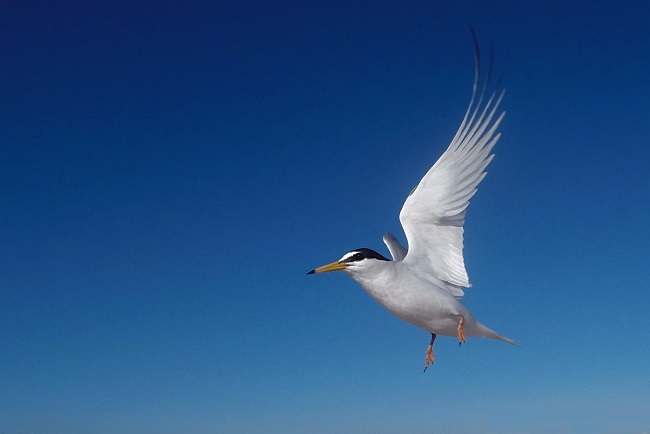Site menu:
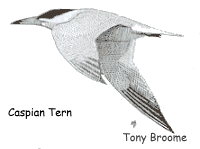
July 2018 Newsletter
Rare Terns on the Dee Estuary.
June Bird News.
Colour Ring Report.
Forthcoming Events.
Latest Newsletter.
Rare Terns on the Dee Estuary and North Wirral
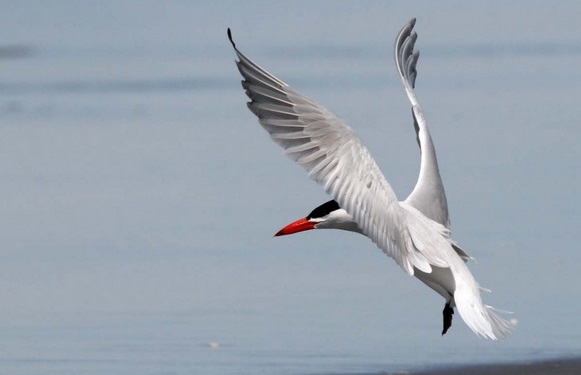
Elegant, noisy and charismatic, terns are many people's favourite group
of birds and we are lucky that the Dee estuary and north Wirral coast
is one of the best places in the country to see them. The Dee Estuary
has recorded 11 of the 17 Tern species on the British list (not
including a possible Royal Tern), and below I
detail six of the rarer species.
Note: Species listed are all BBRC Rarities, except for White-winged Black Tern which was a BBRC rarity up to 2005. There are a few records which are documented elsewhere, mainly in the relevant local Bird Reports, but don't appear to have been submitted to BBRC and these have been listed below in brackets and regarded as 'probables'. The 1974 Royal Tern record was eventually deemed 'not proven' but I include it here for interest.
Gull-billed Tern Gelochelidon niloticaSeven records and two 'probables'.
1976 Hoylake, Hilbre and Red Rocks August 2nd and 4th.
1982 Hoylake July 8th.
1984 (Gronant July 11th to 13th).
1989 Inner Marsh Farm RSPB June 16th.
2002 Inner Marsh Farm RSPB May 18th.
1993 (Point of Ayr June 5th).
2015 Burton Mere Wetlands RSPB July 3rd.
2018 Burton Mere Wetlands RSPB May 23rd and 24th.
Despite being a rarity in the UK this marsh tern has a widespread, but
discontinuous, distribution being found in southern Europe, right
across
Asia and Australia, as well as in both North and South America. It's
stronghold in western Europe is Spain with small numbers breeding in
Denmark and Germany.
The total number of accepted records in the UK from 1950 to 2016 was
311 and current trend is 3 to 4 UK records per year.
Caspian Tern
Hydroprogne caspia
One record (plus six in inland Cheshire and five along the
North
Wales
coast).
The biggest tern in the world, this one was watched sitting on the sand
next to Hilbre. They breed in the
Baltic where there are indications of recent increases both there and
on the Black Sea, these European breeders winter in West
Africa. Other populations are found in Asia, Australia, South Africa
and North America.
The total number of accepted records in the UK from 1950 to 2016 was
295 and current trend is about five UK records per year.
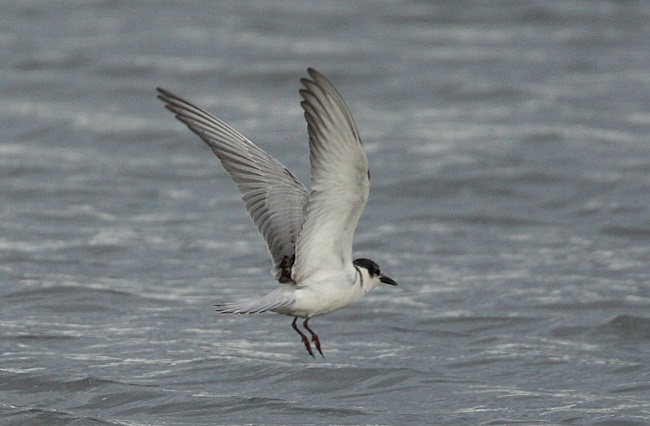
Whiskered Tern Chlidonia hybrida
Three records. Note that it was recorded both in England and Wales at IMF in 2008 and 2010, but Shotwick Boating Lake records weren't submitted. In addition there have been several records in inland Cheshire including four together in 2005.
2008 Inner Marsh Farm RSPB (and Shotwick Boating Lake) May 9th to 20th.
2010 Inner Marsh Farm RSPB (and Shotwick Boating Lake) September 18th to 29th.
There are several thousands of this species breeding in western Europe
with a good number of pairs in France, as most of the UK records are in
May it would seem they are likely to be over-shooting migrating birds.
The western European population winter in tropical West and central
Africa. There are also breeding populations scattered across Africa,
India, east Asia and Australia.
The total number of accepted records in the UK from 1950 to 2016 was
200 and current trend is about five UK records per year.
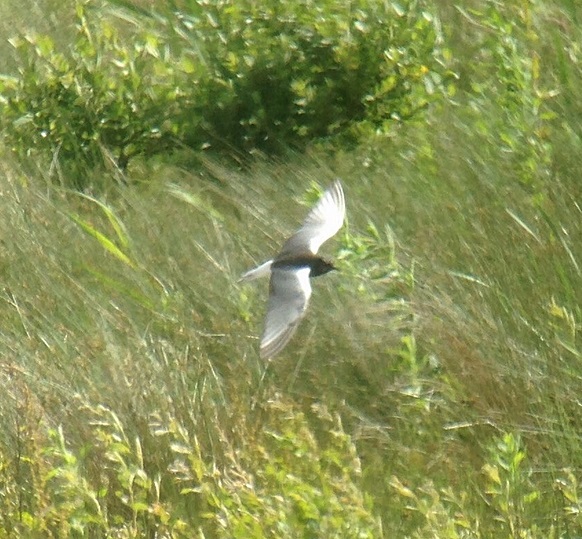
White-winged Black Tern (also known as White-winged Tern) Chlidonias leucopterus
Ten records and one 'probable' record of three birds (plus 12 more in inland Cheshire). Some reports suggest that the bird at Gronant in 2003 may well have been present for several days prior to July 8th, it doesn't appear to have been submitted.
1971 New Brighton August 30th.
1975 Shotton June 29th.
1979 Shotwick Boating Lake October 10th to 13th.
1980 (Point of Ayr - three birds together July 25th).
1982 Hilbre October 2nd to 3rd.
1993 Inner Marsh Farm RSPB July 20th to 21st.
2003 (Gronant July 8th), Hilbre July 9th and 13th, and Hoylake July 13th.
2008 Shotwick Boating Lake September 11th.
2010 Inner Marsh Farm RSPB October 14th to 18th.
2016 Burton Mere Wetlands RSPB, Connah's Quay NR and Shotwick Boating Lake all June 17th.
The classic marsh tern spending both the breeding season and winter on
freshwater
marshes, unlike Black Terns which winter at sea. They breed in eastern
Europe where it is estimated there are up to 200,000 pairs, with many
more
across central Asia. The European population winters in
sub-Saharan Africa.
The total number of accepted records in the UK from 1950 to 2005 (after
which it was considered no longer a BBRC rarity) was 757.
Forster's Tern
Sterna
forsteri
Four records (plus 10 more along the North Wales coast involving at
least four birds).
1986 Point of Ayr - also seen at Abergele, September 27th to August 6th.
1987 Gronant August 20th to September 20th with two present from August 31st.
A mega-rarity.
At the time the 1984 bird was seen it was only the UK's sixth record,
the first being seen as recently as 1980. By 2016 there had been a
total of 21 records in the UK. There were a cluster of records along
the
North Wales coast between 1984 and 1989, where aged these were all
adults, two together at Gronant in 1987 means more than one
bird was
involved.
This species breeds in North America and winters in the
USA and Mexico. The recent run of records in the UK and Ireland has
been attributed to an increase in numbers along the North American
Atlantic coast.
Royal Tern
Thalasseus maximus
One record, first accepted then subsequently 'not proven'.
It's always frustrating when a record is rejected, particularly so when
it is a mega rarity like a Royal Tern, and doubly so when you are first
told it has been accepted but then rejected on review. At the time it
was the British Isles' fourth record (including one in Dublin), but
over the years not only has the Hilbre/POA bird been rejected after
review but also one recorded in Kent in 1965 and one in Cornwall in
1971. The first British record is now one recorded in Glamorgan in
1979. North Wales did eventually see a Royal Tern with one in
Caernarfonshire in 2009, at the time the UK's fifth accepted record.
There are two sub-species, known as West African Royal Tern
and American Royal Tern. It has long been thought these could
actually be separate species and recent DNA analysis has confirmed
that, so we can expect an announcement that these two have been split
any day
now.
The problems with identification of large terns, as seen in the 1980s, involved the separation of Royal, Caspian, Elegant and Lesser Crested Terns. There have been several articles in British Birds on this subject including 'Identification of large terns' by S.J.M. Gantlett in British Birds (80, June 1987).
For your interest below is a short
piece Kenny Dummigan wrote for the
Cheshire Bird Report about the 'Royal Tern', written before the
subsequent review and rejection:
On 8th September 1974 I visited Hilbre Island following a force 9 westerly gale. The wind had swung WSW force 8 and consequently there was little passage of seabirds. After the tide at 1400 hours in bright sunlight, J. Gittins, R. Anderson and I (K. A. Dummigan) were standing on top of the disused lifeboat station when I chanced to glass a flock of Sandwich Terns heading WSW only 50 metres away at eye level. I was immediately drawn to a large white tern with a coral red bill. We obtained fine views of the bird as it flew powerfully and directly past us towards Point of Ayr.
Bare parts: bill large and unmarked, coral red; eye dark; legs appeared dark.
Plumage: very pale (as pale as Sandwich Tern) with pure white undersides and tail; upperwing pale pearl-grey; underwing pale pearl-grey becoming darker on primaries (darker grey); black cap with pale patch on forehead; tail was pure white and slightly forked. The bird was much larger than accompanying Sandwich Terns and was probably between Common and Herring Gull in size.
Initially the bird was submitted to BBRC as a Caspian Tern, due to emphasis in the literature on bill colour, that of Caspian being described as ‘blood red' and of Royal as 'orange'. No real emphasis was found in any of the books consulted on the diagnostic colour of the undersides of the primaries, Caspian having extensive dark grey (almost black) and Royal a far less extensive area of dark grey under the primaries. On seeing Caspian Terns for the first time (in the Camargue, May 1975), I was struck by just how black the under primaries appeared compared with the Hilbre bird. BBRC had meantime received an independent description from the Point of Ayr on 22nd September, and accepted the record as a Royal or Caspian Tern. Further research revealed that bill colour is of little importance due to considerable variations, and the underwing colour and pale forehead were both pointers to Royal Tern. The record was re-submitted as a Royal Tern, and accepted as the fourth British record.
K. A. Dummigan
References
1. As always with Rare Birds the primary source of information, either directly or indirectly, comes from the BBRC (British Birds Rarities Committee) 'Reports on rare birds in Great Britain'. These are published annually in British Birds, and can be found on-line at https://www.bbrc.org.uk/resources.
also of great help were:
2. Allan Conlin and Eddie Williams, Rare and Scarce Birds of Cheshire & Wirral, 2017 (see http://www.deeestuary.co.uk/news1117.htm).
3. Robin Sandham, Scarce and Rare Birds in North Wales, 2017 (email: robinsandham@hotmail.co.uk).
4. Cheshire and Wirral Bird Reports, CAWOS.
5. Clwyd/North East Wales Bird Reports, Clwyd Bird Recording Group.
6. BirdGuides - https://www.birdguides.com/.7. David Cabot & Ian Nisbet, Terns, New Naturalist (Collins), 2013.
8. J.D. Craggs, Hilbre, Liverpool University Press, 1982.
Richard Smith.
Top of PageColour Ring Report
June is a quiet month and, as a
consequence, I had thought not to include a 'Colour Ring
Report' in this newsletter - then suddenly I've been overwhelmed with
records! There's been a lot of Knot records - not from the Dee estuary
but of birds seen here last winter being recorded elsewhere, both of
birds moving north to breed and non-breeding birds staying in the UK.
As I'm still waiting for a lot of records from Iceland I will hold fire
on these but I have a feeling there are going to be a LOT of knot
records being reported in the coming months - see "Among
Knots" if you want to know what this is all about.
Over the past three years there has been a big effort to study Little
Terns by colour-ringing them, and, thanks to Henry Cook of the Gronant
Wardens, I list some interesting 2018 recoveries including the
oldest Little Tern ever recorded. Also details of our
first ever colour-ringed Curlew.
Little Terns
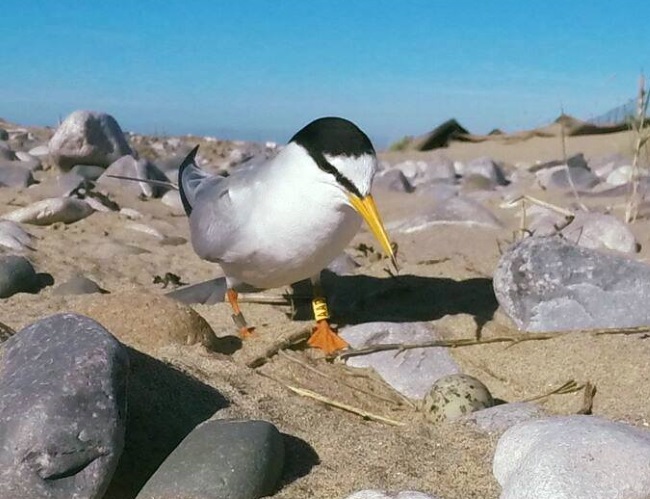
AAD - (photo above, taken under licence) seen on a re-lay nest, This is a 2004 chick born in Kilcoole, Ireland but had a colour-ring added in 2014 on the Isle of Man. It may have tried to breed on the Isle of Man this season before failing and starting again at Gronant as this is the first time this season it's been seen here this season. Waiting for confirmation on this.
XVX - an adult trapped this year, lost it's nest on 14/06 to flooding and found on 22/06, visiting two re-laid nests. Appeared to be incubating both but need to take another look to see what's really happening.
XLL - ringed in 2016 as a chick. This is the first 2-year old confirmed breeding at Gronant. It was suspected this was the case although it appears that more start at 3 years of age.
I43 - a bird likely born at Baltray, Ireland, seen on a nest. Lends more weight to the theory that Gronant recruits birds from other Irish sea colonies.
ZBA - an adult trapped recently that had a metal ring on, applied in 1993! In a couple of weeks it turns 25 years old, a new longevity record for the species. Still breeding at this good old age, indeed one of it's chicks hatched shortly after.
Curlew
FAC
- black letters on white ring (left tibia).
Ringed as a juvenile at Haapavesi, Kyokyla, Finland on July 6th 2017.
Recorded on June 21st 2018 at Hoylake Shore.
This is the first colour-ringed Curlew on our books and demonstrates
that at least some of the young non-breeding Scandinavian
Curlews which over-winter on the Dee also spend the summer here.
Richard Smith. Colour-rings were also recorded by Steve Hinde and Henry Cook, plus the rest of the Gronant Little Tern Wardens.
Top of PageJune Bird News
It was certainly unfortunate that Storm Hector struck on the same day
as the highest tide of the month with a storm surge of one metre on top
of a predicted height of 9.6m - as a result the waves crashed
over the Little Tern colony at Gronant. At least 110 of the 174 nests
were lost and it was feared many of the others would no
longer be viable. However, Little Terns are nothing if not resilient
and most of the eggs in the remaining nests have now successfully
hatched. Not only that but 80 new nests have been relaid. So the good
news is that it looks like we are going to have another successful
season at Gronant despite the storm and with yet another record number
of nesting pairs.
At Shotton 349 'Apparently Occupied Nests' were counted, slightly down on 2017 but the same as 2016. Unfortunately, the recent spell of hot weather has resulted in quite a high rate of chick mortality, it is the ones have just hatched which are at risk but I've been told the older ones were doing OK and the Merseyside Ringing Group have successfully ringed 240 of these.
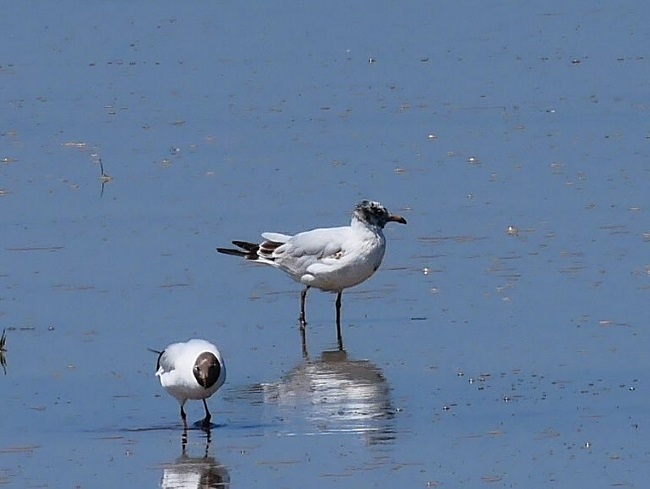
The gull and tern roosts were a bit slow to build up through the month,
which I take as a sign they are having a good breeding season. The
first Mediterranean Gull wasn't recorded on the coast until the 28th
when in 2017 several had been seen; I've been told a pair bred
successfully again at Burton Mere Wetlands where there were also a
large numbers of breeding Black-headed Gulls with chicks still present
at the end of the month. They are obviously having an excellent
breeding season all round at BMW and on the 28th the report was of 50+
Avocet chicks, 45+ Redshank chicks, 100+ Lapwing chicks and a creche of
21 young Shelducks.
There were five Red Kite records through the month, making 20 in total for the year - a big increase on recent years with a total of just six in 2017 and four in 2016. There were quite a few Marsh Harrier records, including a pair which have attempted to breed.
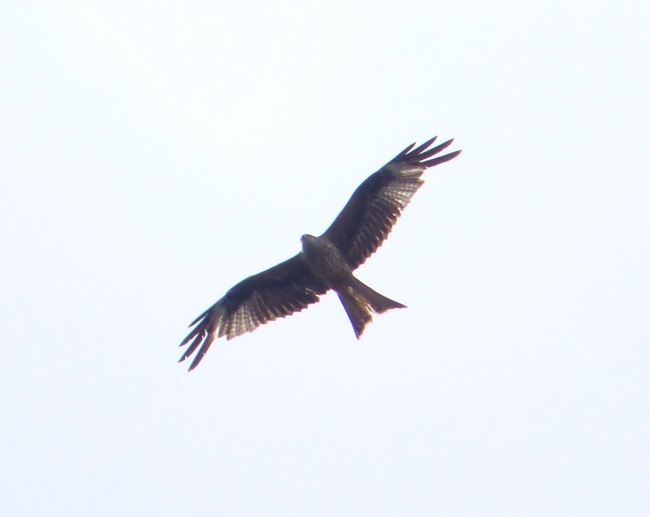
Many thanks go to Charles Farnell, David Haigh, Steve Hinde, Matt Thomas, Chris Butterworth, Elliot Montieth, David Leeming, Alan Hitchmough, Steve Williams, Dave Edwards, Derek Bates, Allan Conlin, Karen Leeming, Frank Burns, David Thompson, Paul Mason, Henry Cook, Jeff Cohen, Graham Jones, 'Fran', Ray and Toni Sherlock, Graham Thompson, Richard Beckett, Ron Armstrong, Peter Coffey, Greg Roebuck, Hugh Sewart, George Knight, Andrew Jones, Ian Goldstraw, Martin Kalaher, Ian Hughes, Mary Laloli, Chris Schofield, Alan Irving, Gary Bawden, David Small, Martin Horton, Don Macintosh, Richard Parker, Clive Part, Alan Kirkham, the Lighthouse and Wirral Birding Blog, the Dee Estuary Wardens and the Hilbre Bird Observatory for their sightings during June. All sightings are gratefully received.
Top of Page
What to expect in July
Gull numbers also build up and the combined gull and tern roosts can be a spectacular sight, one species in particular to look out for are Mediterranean Gulls which will still be in full breeding plumage early in the month, we can get up to 10 or more in the area.
Wader numbers will increase and we should see both Common and Wood Sandpipers, as well as good numbers of Whimbrels, Black-tailed Godwits, Redshanks, Dunlins and Curlews.
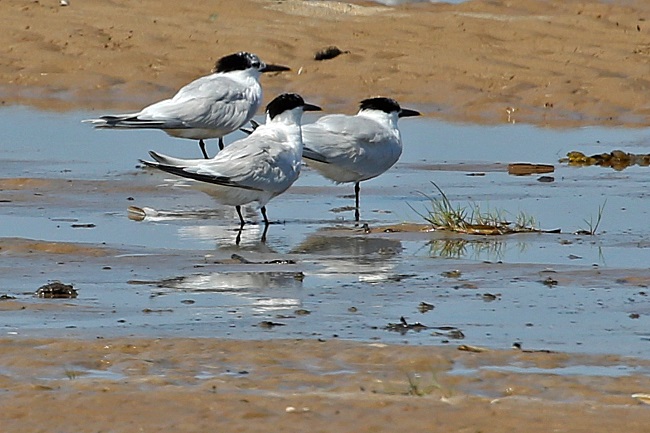
Top of Page
Forthcoming Events
July Highest Spring Tides (Liverpool)
Also see Tides page.
14th July, 12.48hrs (BST),
9.7m.
15th July, 13.38hrs (BST), 9.7m.
Forthcoming Events
Organised by the Wirral Ranger Service , Flintshire Countryside Service and the RSPB (Dee Estuary): All these events and walks have bird interest, even those not advertised specifically for birdwatching. No need to book for these events unless specified - please check below.
Little Tern Events and Tasks at Gronant.
Feel free to just turn up but if you need further details please email nwlittletern@gmail.com or ring Denbighshire Countryside Services 01745 356197. Park at the car park opposite Crofters Pantry Cafe on Shore Road, Gronant (Shore Road is sign posted 'Lower Gronant/Presthavens' from A548). See Article and Gronant Map above.
Thursday 5th July - Seabird Thursday at Gronant.Guided walk to the Gronant Little Tern colony from Shore Road Car Park, Lower Gronant. Part of the Denbighshire Countryside Service 'Out-and-about' programme. 9.30am-12pm. Free event.
Sunday 8th July - Official Opening of the new Visitor Center and Monitoring Hide at Gronant. 12-1.30pm. Meet at the Shore Road Car Park. Drinks and a tour of the site with the North Wales Little Tern Group.
15th-16th July - Debris clearance from fencing at Gronant Little Tern colony following Spring tides. Meet at the Visitor Center by the Little Tern colony. 2pm each day. Bring gloves.
Wednesday 11th July and Monday 23rd July - Wildlife Wander at RSPB Burton Mere Wetlands.
1pm start. Price: £5 per person / £4 RSPB members / normal reserve entry charges also apply to non-members. Join one of our friendly, knowledgeable volunteers for a leisurely amble around much of Burton Mere Wetlands, including the unmissable viewpoint at the end of the Hillfort Trail on Burton Point. Take in the sights and sounds, learn more about the wildlife that thrives here, the work we do to give nature a home and the remarkable history of the estuary. Great for first time visitors or those looking to brush up on their identification skills; with constant changes as we move through the seasons, it's impossible to predict what might be seen. Spring and early summer is a wonderful time as we will begin to have lots of new arrivals showing their faces including some of our well-travelled migrants like the warblers, and lots of butterfly activity on warm sunny days. The heron and egret colony is noisy as their young start to hatch and chatter loudly amongst themselves, whilst the reserve is awash with an array of wildflowers coming into bloom. Booking not essential, but places are limited. A reasonable level of fitness and sturdy footwear are required. Walks typically last up to 3 hours, weather permitting.Ring 0151 353 2720 for further details.
Sunday 19th August - 'Liverbird' Birdwatching and Nature Discovery Cruise.
Mersey Ferries and the RSPB are hosting a 'Liverbird' Bird Watching & Nature Discovery Cruise on the River Mersey and out into the bay, on Sunday 19th August. The cruise is perfect for families and both new and experienced watchers. Sightings have previously included long-tailed skuas, peregrine falcons, osprey and Atlantic grey seals. Experts will be on-hand to answer your questions and help with the spotting of wildlife. Booking Essential. Buy tickets on-line:
https://www.merseyferries.co.uk/cruises/special-cruises-and-events/Pages/
Wildlife-and-Nature-Discovery-Cruise.aspx
